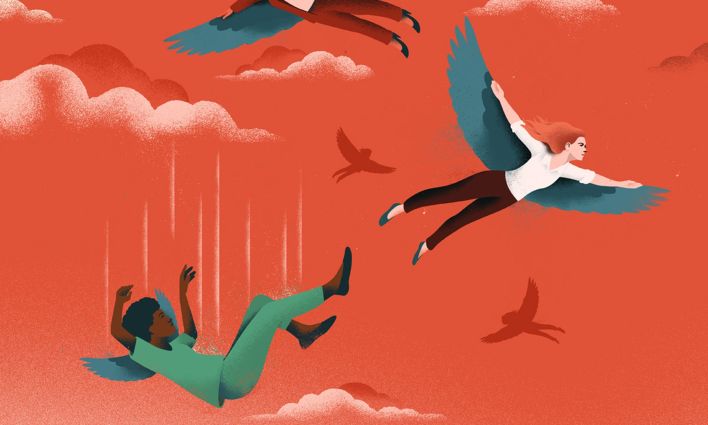Women have been frontlined and sidelined by the pandemic – in their roles as primary caregivers and care workers in the public and private sectors and the majority of workers in sectors hardest hit by ongoing economic shutdowns. Women were certainly not all in the same place going into the crisis and their lives since February 2020 have followed different paths. Those groups and communities least able to shoulder the social and economic fallout of COVID-19 are now struggling under its weight.
This research looks at the ongoing impact of the COVID-19 pandemic on the economic security of women in Canada and the current efforts to respond to urgent economic need in the short to medium term and demands for fundamental systemic change looking forward. It presents an overview of both national and provincial-level trends and policy responses – recognizing the varied experiences of the pandemic across the country as well as differences in the degree to which concerns about gender equality have figured in federal and provincial recovery planning.
Its goal is to provide crucial context and a starting point to assess the differential gendered impact of the economic crisis and the current policy and program prescriptions on offer. COVID-19 has certainly made clear, once again, how fundamentally intertwined the economy is with women’s unpaid and undervalued labour. It has also shown the critical role that the social safety net plays, or fails to play, in times of crisis – and the ways in which gender bias informs welfare state policy, limiting women’s economic choices, reproducing systemic oppression and privilege in the process. There remain significant gaps in the types of income supports and public services currently available to support women’s engagement in the paid labour market and their roles as caregivers – gaps that demand an intersectional and feminist response.
Women’s economic progress set back by decades in two short months
From health to the economy, physical security to income security, the COVID-19 crisis has magnified and exacerbated existing gender disparities. The economic, health, and social fallout of the pandemic has disproportionately impacted women and those who belong to Indigenous, Black or racialized communities, immigrants and refugees, women living with disabilities and members of 2SLGBTQQIA+ communities.
Women also represent the majority of workers in sectors hardest hit by the economic shutdown this past spring and in the current wave of layoffs in sectors such as accommodation and food services, child care services, personal services and retail trade. Large numbers of racialized women and immigrants work in these areas which include some of the lowest paying and most precarious jobs in Canada.
Low-wage workers, overwhelmingly women, highly racialized, and facing the greatest barriers to employment, accounted for the largest share of these losses. Over half (58%) of all female workers earning less than $14 an hour or less were laid off or lost the majority of their hours between February and April.
Women have also faced an exponential rise in unpaid labour, taking care of loved ones, homeschooling, provisioning supplies, and finding ways to shoulder the enormous economic and social burdens of this time. Large numbers have ended up scaling back their hours or leaving paid employment all together – sacrificing their financial security and the security of their families.
Women’s uneven economic recovery ground to a halt as the second wave took hold
Today, more women are back at work and have picked up lost hours, but the recovery remains as inequitable as the downturn and women’s economic security is fragile. By almost all metrics, the gap between men and women’s labour market experiences has widened.
In the labour market, women’s total hours worked (at a main job) dropped by -3.9 percentage points nation-wide between October and November. Total hours worked declined again in December with the introduction of further restrictions and closures in many provinces, here including Quebec and Ontario. And a further decline in both January and February.
By year end, female workers were working roughly 10% fewer hours in the aggregate than before the pandemic, while the December employment rate (55.3% 15+ years) was 2.7 percentage points below the rate posted in February, the same level of employment as in 2000.
The greatest gap in hours was in Prince Edward Island where women were working -22.2% fewer hours relative, in Nova Scotia (-11.8% fewer hours) and in Manitoba (-10.3% fewer hours), all relative to February 2020.
As of December, employment among young women (15-24 yrs) remained farther (-12.1%) from pre-pandemic February levels than that of other major age groups and their employment rate was still 7.1 percentage points below February levels (at 52.3%).
Low-wage workers, overwhelmingly women, highly racialized, and facing the greatest barriers to employment, accounted for the largest share of these losses.
Many mothers giving up on employment, exiting the workforce
Mothers have a particularly long road ahead. By August, fathers had effectively recouped all of their employment losses, while 12% of the mothers who were working in February were still without work or working less than half of their regular hours.
On this score, single mothers have experienced the greatest economic challenges compared to fathers and mothers in two-parent families. By November, single mothers with children under 6 were working -31.0% fewer hours than in February while mothers with school aged children (6-12 years) were working -17.3% fewer hours.
These figures don’t capture the proportion of women who have dropped out of the labour market completely, setting aside their own financial security to care for their families’ needs. As of November, the number of women aged 15 and older “not in the labour force” was almost 160,000 higher than in February.
Women aged 35-39 years, in particular, are exiting the labour force “in droves”, according to recent research from RBC Economics, with mothers of children under 6 years account for two-thirds of the exodus in this key age group.
There is a clear link between the gendered concentration of women in highly vulnerable industries and occupations and the greater likelihood of COVID-19-related employment loss.
Economic challenges are most acute for marginalized workers and communities
These challenges are even more pronounced among women facing intersecting forms of discrimination. Not only does the burden of illness weigh most heavily on these groups and communities, but their economic recovery is unfolding at a much different pace.
In July 2020, there was almost a seven percentage point difference in employment rate between racialized and non-racialized women (57.7% vs 64.4%) and more than an eight percentage point differences in their respective rates of unemployment (17.4% vs 9.2%).
Black, Indigenous, and other racialized women – working in hard hit sectors and occupations – bore the brunt of first wave employment losses. These gaps have narrowed somewhat between July and December but are still significant – and may widen further in the wake of second wave closures.
Indigenous women have fared badly as well. From the three-month period ending in February 2020 to the three-month period ending in May 2020, the employment rate fell from 55.6% to 49.9% among women living off reserve and continued to fall through the summer and fall, reaching 47.8% for the period ending in December.
The concern from the start of the COVID-19 pandemic has been the potential of the crisis to set off a devastating “feedback loop” that will deepen and entrench existing inequalities. Many months into the pandemic, there is clear evidence that these communities are being left behind.
Women’s economic precarity linked to COVID-19 related employment loss
An examination of provincial labour data highlights some of the underlying issues exposing women to heightened economic risk in the context of the current pandemic and similarly identifies areas that demand attention from policy makers and practitioners.
First, there is a clear link between the gendered concentration of women in highly vulnerable industries and occupations and the greater likelihood of COVID-19-related employment loss.
The four Atlantic provinces were able to form a joint “bubble” this summer which kept the virus at bay even as the rest of the country entered the second wave. But even among this group, women lost hours of employment, the result of their above-average concentration in vulnerable industries as well as the sizable drop in demand in tourism over the past ten months. These losses were particularly large in Nova Scotia and Prince Edward Island.
Women’s economic precarity was a key factor explaining above-average employment loss this past spring in British Columbia and Alberta and the surge in employment losses this past fall in Manitoba, Saskatchewan and Alberta.
The sizable cuts to employment in Health services and social assistance in Manitoba and Alberta was another important driver. In Manitoba, female employment in this sector dropped by -8.4% between February and December. And in Alberta, health sector employment is down -2.7% among women.
Exponential rise in unpaid caring demands particularly as it relates to children driving women out of labour force
Following the spring closures of businesses, schools and services, close to 900,000 female workers (aged 15-64 years) left the labour altogether. In two short months, women’s labour force participation rate of those aged 15 to 64 years fell from 75.7% to 68.5% – a level not seen in over forty years.
The participation rate rebounded through the summer, reaching 75.0% in August, and has since stalled. In December, the number of women outside of the labour market was 90,000 higher than it had been in February.
Going into the pandemic, Prince Edward Island and Quebec had the smallest shares of women (aged 15-64 years) not in the labour market, while Newfoundland and Labrador and Ontario had the largest (with a spread of 10 points). Ten months later, there were marked increases in Prince Edward Island, Manitoba, Saskatchewan and Alberta in the numbers of women no long engaged in the paid labour market or searching for work.
This also coincides with the lagging recovery of maternal employment rates, notably in the prairie provinces among mothers with school-age children and in Quebec, Ontario and Manitoba among mothers with pre-schoolers.
In the context of COVID-19, as time passes, many more child care centres will close – restricting the employment of mothers even further. Canada has experienced a similar rise in unemployment and drop in labour force participation. It is likely that, without intervention, we will see these trends here as well.
Join Katherine Scott and Anjum Sultana for a lunchtime discussion of women and the economic crisis, the Canadian response to date, and what we can expect in the upcoming federal budget. Register for free on our website: policyalternatives.ca/march12








